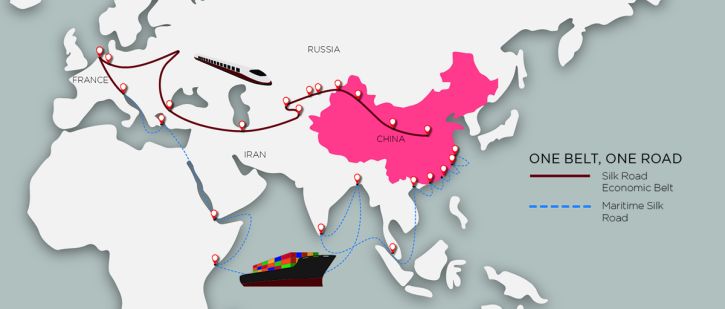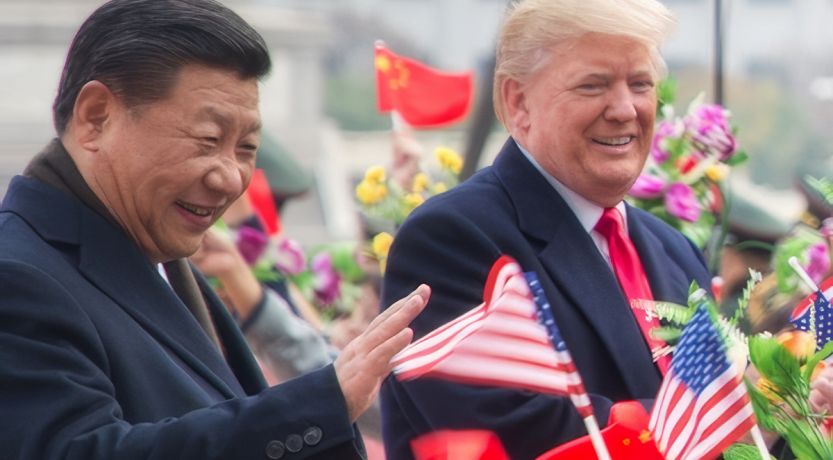With an increasingly ambitious foreign policy and a leader newly infused with unprecedented power, China aims to restore its historical dominance in Asia and beyond. The global implications of this vision are immense.
“China,” Napoleon once remarked, “is a sleeping lion. Let her sleep, for when she wakes she will shake the world.” In 2014, while in Paris, Chinese President Xi Jinping invoked Napoleon’s remark and triumphantly declared that the lion had already awakened.
Mr. Xi has thrown out the “lay low” doctrine of Deng Xiaoping: “hide our capabilities and bide our time; never try to take the lead.” Instead, he has hailed the start of a new era—China’s Dream—with recovery from its “century of humiliation” at the hands of colonial powers like Japan, Britain and France. In a recent address to the Communist Party, He declared that the country “stood up” under Mao Zedong and became rich under Deng, but under Xi it has grown powerful and now seeks to shape the global system.
Exalting the new “emperor”
“Never before has a nation risen so far, so fast, on so many dimensions, as China has over the past generation,” according to Destined for War author Graham Allison. “The same could be said of Mr. Xi, who went from a politically exiled peasant … to ‘Chairman of Everything’” (Wall Street Journal, Oct. 16, 2017).
China’s recent 19th Party Congress—normally an opaque, twice-a-decade reshuffling of uncharismatic technocrats—emphatically ended an era of collective leadership by exalting Xi Jinping, who was already the most powerful Chinese leader in decades, to a second five-year term without an obvious successor, effectively crowning him China’s 21st-century emperor.
Now described as the party’s lingxiu—an honorific title meaning supreme leader that has not been used since the Mao era—Mr. Xi was elevated to the Chinese Communist Party pantheon with “Xi Jinping Thought” officially embedded into the party charter alongside Mao’s, making him politically untouchable.
Princeling, peasant, president
Because of his illustrious roots—born in Beijing in 1953 to a trusted revolutionary colleague and vice premier under Mao—Mr. Xi is seen as a princeling, a child of elite senior officials who has risen through the ranks.
However, shortly after his ninth birthday his father was purged prior to the Cultural Revolution and imprisoned, and his mother was assigned to hard labor on a farm. The younger Xi was sent to the remote countryside for “reeducation” through hard labor for seven years where he was forced to denounce his father while shoveling dung and living in a flea-infested cave. His older half-sister hanged herself because of the abuse, but the exceptionally ambitious young Xi, according to a longtime friend, “chose to survive by becoming redder than red” and clawing his way back to prominence (Evan Osnos, New Yorker, April 6, 2015).
Exhibiting incredible persistence, Mr. Xi—today the leader of a Communist Party with 89 million members—was actually rejected time after time when he sought to join the party. Later, as China grew richer, the unassuming Tsinghua University chemical engineering graduate grew adept at keeping his head down and avoiding ostentatious displays of wealth as he climbed the provincial political ladder, but he was always credited with overseeing spectacular growth.
After election to the presidency in 2013, he was expected to be a bland figurehead and technocratic spokesman of the collective leadership, but Mr. Xi moved with stunning skill, speed and determination, wielding a highly visible anticorruption campaign to purge dozens of powerful rivals and consolidate power.
As former Australian prime minister and noted China expert Kevin Rudd puts it, Xi has a “deep sense of national mission, a clear political vision for the country,” and is “very much a man in a hurry” (as quoted by Graham Allison, Destined for War, 2017, p. 118).
Asserting parity with Washington
Against the backdrop of a newly assertive China and a “post-American age” on the horizon, what was termed a “state visit-plus” for U.S. President Donald Trump recently showcased the hospitality and grandeur of the Chinese capital.
As recently as 2005, China’s economy was less than half the size of the U.S., but it is on pace to be 40 percent larger than America’s by the end of Mr. Xi’s second term. The shift in power and confidence is noticeable.
“China, for the first time, is not in a humble position regarding the United States,” said Yan Xuetong, a professor of international relations at Tsinghua University in Beijing. “Usually the American president has the advantage. This is the first time that there is an equal relationship between the two leaders” (New York Times, Nov. 6, 2017).
Clash of heavyweights
Mr. Xi wants a U.S. admission of parity with China. He has pushed for what he calls a “new type of great power relations,” saying “the Pacific Ocean is big enough for both China and the U.S.” Such a diplomatic concession scares U.S. allies, as it would essentially create a G-2—the U.S. and China carving up the globe between them, with all of Asia falling into China’s sphere of influence.
“China is marching towards its perception of its global destiny.”
Mr. Trump left a vacuum in the region by abandoning the proposed 12-nation Trans-Pacific Partnership (TPP) free-trade agreement, which was envisioned as a buttress against China’s growing influence. Instead, he outlined a vague vision for a “free and open Indo-Pacific region” that stretches from the U.S. to the Indian Ocean.
As the U.S. has retreated from its traditional role on the world stage, Mr. Xi has moved swiftly to chip away at American influence in the region by accelerating efforts to leverage China’s own trade group, the Regional Comprehensive Economic Partnership, which includes 16 nations that together account for 39 percent of global GDP.
Winning without a fight
With Mr. Xi tasking his military to be able to “fight and win” any military encounter, focus has been on the buildup of conventional forces and the transformation of reefs, rocks and sandbars in the South China Sea into forward-based military installations. America’s top military officer, General Joseph Dunford, recently sounded an alarm, telling the U.S. Congress that China is likely to be the “greatest threat” of any foe to the U.S. within the decade since “China is focused on limiting our ability to project power and weakening our alliances in the Pacific.”
Ancient Chinese strategist Sun Tzu’s maxim “subdue the enemy without fighting” reveals China’s primary direction today. As former U.S. Secretary of State Henry Kissinger explains in On China, victory for Sun Tzu was “not simply the triumph of armed forces,” but “the achievement of the ultimate political objectives” that a military clash would be intended to secure. “Far better than challenging the enemy on the field of battle is … maneuvering him into an unfavorable position from which escape is impossible” (2011, p. 28).
Made in China 2025
Under an ambitious plan called “Made in China 2025,” Beijing began investing billions of dollars in domestic research and acquisition of innovative foreign technology. They targeted cutting-edge technologies like advanced microchips, artificial intelligence and quantum computing as keys to growth.
“If ‘Made in China 2025’ achieves its goals,” says Jeremie Waterman, president of the China Center at the U.S. Chamber of Commerce, “the U.S. and other countries would likely become just commodity exporters to China—selling oil, gas, beef and soybeans.”
In 1980 China’s trade with the outside world amounted to less than $40 billion; by 2015 it had increased a hundredfold, to $4 trillion. China has become the largest trading partner of over 130 countries, with every country and company fearing potential lost access to the market of 1.4 billion customers.
China was built in a day
Former Australian Prime Minister Kevin Rudd described the country’s economic explosion as “the English Industrial Revolution and the global information revolution combusting simultaneously and compressed into not 300 years, but 30” (New Statesman, July 16, 2012).
Recent developments show Rudd’s assessment to be true.
- Between 2011 and 2013, China produced and used more cement than the U.S. did in the entire 20th century.
- Overall, China built 2.6 million miles of roads—including 70,000 miles of highways—between 1996 and 2016, connecting 95 percent of the country’s villages and overtaking the U.S. as the country with the most extensive highway system by almost 50 percent.
- In the past decade, China has constructed the world’s longest high-speed rail (HSR) network: 12,000 miles of rail lines that carry passengers between cities at speeds of up to 180 miles per hour. China now has more HSR tracks than the rest of the world combined and plans for another 16,000 miles by 2029 (Destined for War, pp. 13-14).
The new Silk Road
Forming the backbone of China’s audacious economic and political agenda is the titanic venture Mr. Xi announced in 2013, introduced as the “One Belt, One Road Initiative” (OBOR). Expected to become the greatest public works project in history, this unparalleled geopolitical and geo-economic game changer—still in its early stages—aims to link countries along the ancient Silk Road trade route with high-speed rail system that will cut the time required to move freight from Beijing to Rotterdam from a month to two days!

At a cost exceeding $1.4 trillion (the equivalent of 12 Marshall Plans), it will incorporate more than a thousand megaprojects spanning three continents and connecting 65 percent of the world’s population to strategically draw countries and companies more into China’s orbit while providing arteries for Chinese goods flowing into Europe.
The “One Road,” or maritime Silk Road, extends from coastal southeast China, touching nearly every country bordering the Indian Ocean, rounding the Horn of Africa, to the Mediterranean. To penetrate the struggling but affluent European market—China’s largest trading partner—Beijing is even financing the upgrade of the Greek port of Piraeus.
Similarly, the “One Belt” will be a colossal network of railroads, pipelines, highways and land bridges forming high-speed economic corridors to commercialize all of Central Asia—Pakistan, Russia, Iran, Turkey, Indochina and India.
Clash of ambitions
“The outcome of this clash of national ambitions will be one of the great, perhaps perilous stories of the next several decades,” said David M. Lampton, a professor at the Johns Hopkins School of Advanced International Studies (New York Times, Nov. 6, 2017).
“China is marching towards its perception of its global destiny,” notes Kevin Rudd. “It has a strategy. The West has none” (Financial Times, Oct. 22, 2017).
The sure word of prophecy
Bible prophecy gives no specifics of a major conflagration between China and America, but it does reveal that the modern descendants of the 12 tribes of Israel, including the United States, will have their power broken due to their national sins and rejection of God’s ways (Leviticus 26; Deuteronomy 28).
Further on in prophecy, one reads of the end-time event when a vast army led by “the kings from the east” will travel, perhaps along a modern Silk Road, to be gathered along with other nations at Armageddon for the battle of that great day of God Almighty (Revelation 16:12, 13-14, 15-16).
To learn more, download your free copy of our booklet The Book of Revelation: The Storm Before the Calm and sign up for our News & Prophecy Insights blog.





